
The rehabilitated Mill Road Bridge near Kennett Square.
Local residents have expressed a strong desire for rehabilitating the Landenberg Bridge bridge in a historically appropriate manner and for maintaining the current look and feel while upgrading the load capacity to accommodate modern emergency vehicles. For safety reasons the current 19-ft roadway width on the bridge will be maintained since it has functioned well over the years in slowing traffic coming down the steep Landenberg Hill before entering the pedestrian area of the village. Note: it was decided to increase the roadway width slightly to 20-ft to give two full 10-ft lanes.
The plans attempt to follow the spirit of the Standards for Historic Rehabilitation outlined in the Secretary of the Interior's Standards for the Treatment of Historic Properties (rev 1992). Rehabilitation is "the act of making possible an efficient compatible use for a property through repair, alterations, and additions while preserving those portions or features which convey its historical, cultural, or architectural values." The goal for the bridge rehabilitation project is to preserve the historic character of the bridge, preserving as much of the original historic metalwork, stonework and spatial relationships as possible, while upgrading it from its horse-and-buggy load carrying capacity to meet modern needs.

The rehabilitated Mill Road Bridge near Kennett Square.
About ten years ago, Chester County successfully rehabilitated an historic bridge on Mill Road near Kennett Square. Although the Mill Road Bridge is somewhat smaller (50 ft span, one lane) than the Landenberg Bridge (80-ft span, two lanes), both bridges were originally Pratt Pony Truss bridges. It is proposed to use techniques developed for that project on the Landenberg Bridge project. The County Engineers involved with that project published a technical paper on that project.
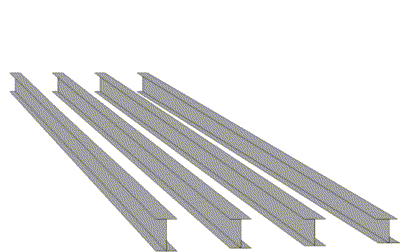
On the Mill Road Bridge, the old bridge was disassembled and
removed. A new bridge structure was built consisting of a set of
18" girders spanning the entire creek.
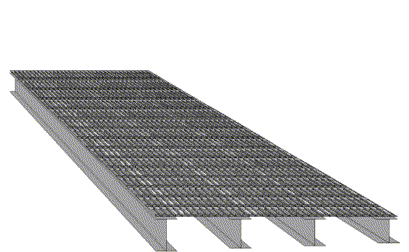
On top of these girders was placed a road-bearing surface
consisting of a steel grid deck that covered the entire road
surface area. These girders and grid deck comprised the main
structural elements of the new bridge and were designed to give a
20-ton load capacity.
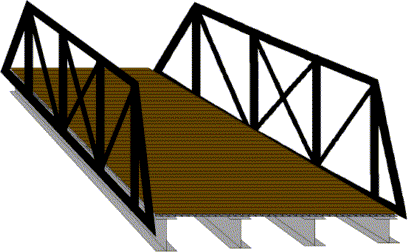
The old bridge's trusses was cosmetically refurbished and
attached to the sides of this new bridge. A cosmetic wooden deck
with an anti-skid grooved surface was placed over the steel grid
deck. The result was a modern bridge with a high load capacity
that looks very similar to the old bridge. Only from underneath
and sides is the modern work readily apparent.
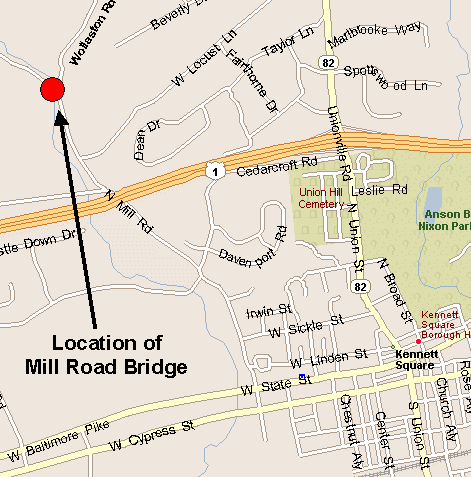
The Mill Road Bridge is northwest of Kennett Square and is near
enough to be easily visited by township residents wishing to view
the results of that project.
It is apparently impractical to "fix" the Landenberg Bridge's Pratt Pony Truss structure in such a way that it would be safe to carry the weight of modern emergency vehicles. The trusses in their original pristine condition would only be good for about 9 tons. For this reason, a different structural system is needed. Modern girders can carry much higher weights than the truss system employed on the Landenberg Bridge. The rehabilitated Mill Road Bridge design cleverly combined the modern structural girder span technology with the historic aesthetics of the old Pratt Pony Truss bridge.
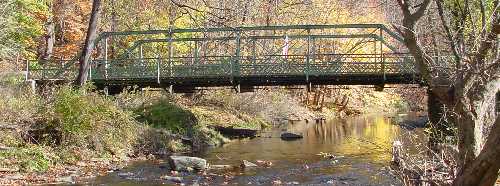
The Landenberg Bridge is a Pratt Pony Truss. Note that the bridge
deck appears fairly light since the bridge's strength is all in
the truss above it.
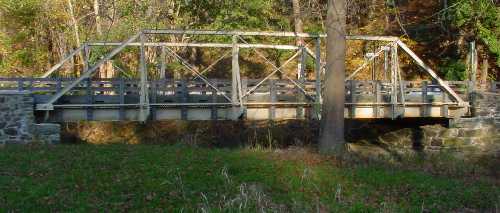
The rehabilitated Mill Road Bridge is structurally a girder
bridge. These historic trusses are now only ornamental with no
structural purpose. Note the bridge deck now appears fairly thick
in comparison due to the new girders.
As was done on the Mill Road Bridge, the historic metalwork on the Landenberg Bridge that is to be preserved would need to be straightened, cleared of rust, cleaned and repainted. The temporary metal plates placed on the over the truss pins recently to keep the truss members from separating should be removed and damaged truss pins and end-caps should be replaced as necessary.
Some research is needed to determine the most appropriate color to paint the historic metalwork. It may be possible to determine the original color of the bridge by digging down through the old layers of paint. Research on the Mill Road Bridge determined that tan was the most appropriate color. Alternatively, the pale blue-green color of the current bridge may be preferred. Note: when the original plans were found in the County archives, it was discovered the bridge was originally painted with a white and red paint scheme, however it was decided to retain the current bridge color.

There were originally two plaques similar to this one from the
Mill Rd bridge. Both of the ones on the Landenberg Bridge have
disappeared. Research of plaques from similar bridges will be
needed to recreate them.
The cantilevered sidewalk is one of the distinctive contributing factors that put the Landenberg Bridge on the National Register. The rehabilitated bridge should preserve this feature.

The sidewalk support brackets are attached to the ends of the
floor beams. The rehabilitation of the Mill Road Bridge was done
by cutting off the ends of the floor beams and attaching them to
the new girders. This should be done for the Landenberg Bridge as
well, while ensuring the means of attachment is strong enough to
bear the weight of the sidewalk as well as the trusses.
The stonework for the Landenberg Bridge was constructed in 1871 for the previous bow-truss bridge on the site. It, along with the 1899 superstructure, is part of the National Historic Register listing. The original stonework consisted of the two abutments and four extensive wingwalls.
It has been decided to reconstruct the original stonework using formliners - cast in place concrete. This is both less expensive in the reconstruction phase, but is also expected to be less expensive to maintain. Examination of the use of formliners for other historical bridge projects has shown that, if done correctly, the results are more than acceptable.
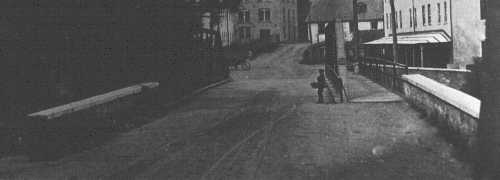
The original eastern wingwalls (as seen about 1905) have
disappeared and should be rebuilt.

The original western wingwalls (as seen about 1905) are still
present, but are in poor condition. The northwest wingwall
(visible to the right of the bridge in the above photo) is
missing large sections and will probably need to be completely
rebuilt. The top portion of the southwest wingwall (partially
hidden behind the left truss in the above photo) has been knocked
off and is resting below at stream level. This needs to be
repaired.
The southwest wingwall (near the hotel) originally included a stone plaque that recorded the date and builder of the 1871 bridge and stonework. It was removed at an unknown time and is now mounted inside a basement wall of the Wool House across the street. William Skalish, the owner of the Wool House, has offered to donate the stone back to be mounted in its original location on the wingwall.
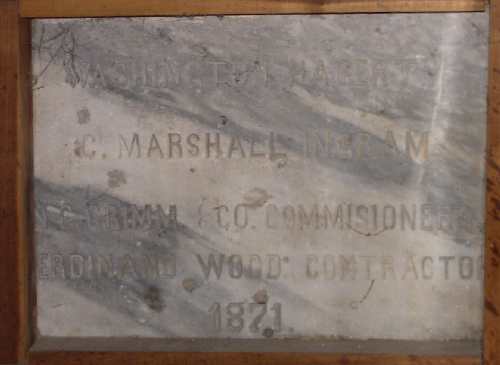
The 1871 stone plaque (now in the basement wall of the Wool
House) lists the County Commissioners that authorized the 1871
bow truss bridge and lists the contractor (Ferdinand Wood) who
did the stonework that is still in use today.

The current sidewalk decking on the Landenberg Bridge ends just
outside the truss. The large gap between the sidewalk and the
roadway is dangerous and is easily large enough for a child to
fall through into the stream below. The iron pipe railing on the
outside of the truss, something added relatively recently, does
little to ameliorate the danger.
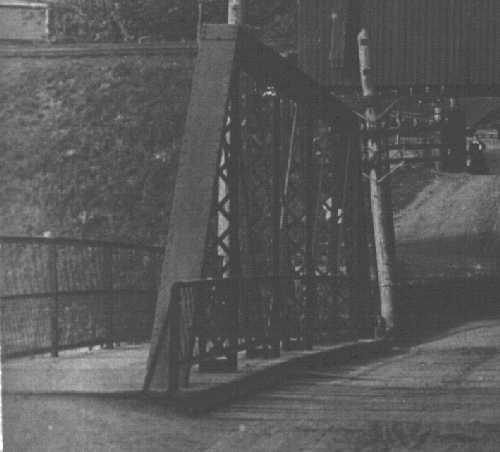
The above historic photo shows that the sidewalk decking
originally went all the way through the truss to above the edge
of the roadway. This original design had no dangerous gap.
When the bridge is rehabilitated, for both historic and safety reasons, the new sidewalk deck should extend through the truss to the edge of the roadway as it was done originally. The inappropriate iron pipe railing on the outside of the truss should be removed.
Following the Mill Rd bridge project's lead, it would seem wise to add guard rails. There have never been guard rails on the Landenberg Bridge, so this would be a modern addition, but it would help protect the the carefully restored trusses from possible future vehicle impact damage.

The Mill Road Bridge utilized long-lasting Ekki wood in the
construction of the railings (as well as the deck). This was
considered more aesthetically appropriate than metal railings
would have been.
The railings should probably extend some distance beyond the ends of the trusses to provide appropriate protection for the trusses, but not obstruct access to the sidewalk. Having guard rails will probably make it necessary to place the trusses slightly further apart than they are on the current bridge so as to maintain the same width 18-ft roadway.
| There are some important trade-offs that the township will have to make between flood opening and road surface height. |
Lictenstein has studied the current Landenberg Bridge and determined that a FEMA 100-year flood will inundate the deck and truss floor system. During such a flood, water will back up behind the bridge, possibly worsening flood damage to buildings in the immediate area. In their designs for a replacement bridge, PennDOT has attempted to not make this 100-year flood situation any worse.

The current bridge has approximately 700 sq-ft of flood opening
beneath it.

A girder design with 18" girders would reduce the flood
opening by approximately 11% to around 620 sq ft if the road
surface were left at the current level.

A girder design with 24" girders would reduce the flood
opening by approximately 17% to around 580 sq ft if the road
surface were left at the current level.
In order to eliminate this flood opening loss, PennDOT has proposed raising the road surface of the bridge and possibly sloping the bridge. The roadway surface would need to be raised an average of 1 ft for 18" girders, or 1-1/2 ft for 24" girders if flood opening loss is to be eliminated..
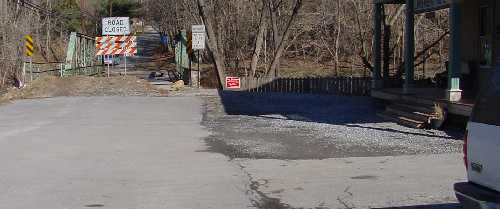
There are practical and aesthetic problems with raising the
roadway surface. Particularly the parking area for the Hotel and
Store would be significantly lower than the road surface. Sloping
the bridge so that the east end is higher than end near the hotel
may alleviate these problems somewhat.
The township has determined that the rehabilitated bridge should have a high enough load rating to allow emergency equipment to cross the bridge.
The Historical Commission has obtained the following information about the weight of various kinds of vehicles that might be expected on the bridge.
| The ML80 is a PADOT vehicle that represents the
maximum legal load permitted on the state highway system.
This truck can be envisioned as a fully loaded quarry
truck and weights 37.74 tons. The vehicle weight of school buses are generally 12 to 15 tons. The total weight of typical fire trucks are highly dependent on the actual vehicle, however, they are generally less than 20 tons for local departments. letter from PennDOT, 8/21/00 |
An enquiry to the Avondale Fire Department produced the following response giving a higher weight for emergency vehicles than PennDOT suggested:
| ...our heaviest piece of apparatus is 61,000 pounds
(30.5 tons) however the heaviest piece of apparatus that
we may need to get across that bridge could be up to
80,000 pounds (40 tons). That would be from a couple of
our mutual aid companies. Our width is 9 foot including
the mirrors and it could be possible that we would have
to pass each other at any given time on that bridge. ... Glenn Hallman |
Load Ratings for bridges is complicated. The load a specific bridge can carry depends on the configuration of the vehicle(s) that are on it. Bridges can usually carry heavier vehicles if there are multiple sets of axles and if the axles are widely spaced, as they are in combinations (e.g. a tractor truck with a semi-trailer having multiple-axles).
PennDOT's Structure Evaluation Report for the Landenberg Bridge (January 1997) calculates that the original bridge (in its brand new 1899 condition) would have been posted for 9 tons (combinations 14 tons). The Landenberg Bridge was downgraded to a 3-ton load rating several years ago when structural problems were first noted.
The concrete bridge proposals developed by PennDOT were all designed for a 45-ton rating ("full legal load") and used 24" thick girders. The Mill Road Bridge was designed for a 20 ton rating and used 18" girders.
A higher load rating necessitates thicker support girders. This requires us to either raise the level of the road surface and/or reduce the flood opening.
Although the engineer should calculate the exact sizing of the girders, we can note that the 20-ton Mill Road Bridge has 18" girders, and the various 45-ton concrete bridge proposals by PennDOT have 24" girders. With 18" girders, we would loose about 80 sq-ft of flood opening if we kept the road surface at the same level; and if we opted for 45 tons by adding 6" additional girder thickness (24" total), we would would lose an extra 40 sq ft of flood opening (120 sq ft total).
It may be possible to obtain a larger load rating while minimizing flood opening loss by using additional thinner girders. For example, instead of four-24" girders, perhaps eight-18" girders might give the desired load capacity. The engineer would need to evaluate such trade-offs for us.
Another possibility is raising the eastern end of the bridge somewhat more that the western end. Tilting the bridge like this would give us some additional flood clearance while reducing the drop from the road surface to the Hotel and Store parking area.
We will also need to look at topping off the stone work to compensate for any raising of the road surface to maintain the visual appearance of the stonework relative to the bridge deck.
New Garden Township and the Historical Commission have retained Sandy Gill Martin, P.E., of McCormick, Taylor & Associates, Inc., of Exton to advise us on the best Historical Rehabilitation techniques to be used on this project. Sandra, when she was employed by Chester County earlier in her career, was one of the engineers responsible for the Mill Road Bridge project.
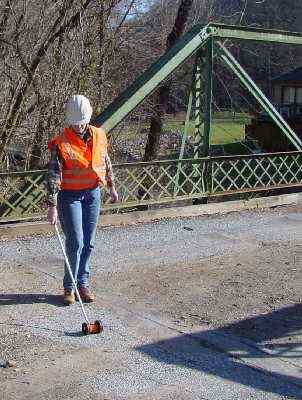
Sandy checks the 19-ft roadway width of the bridge.